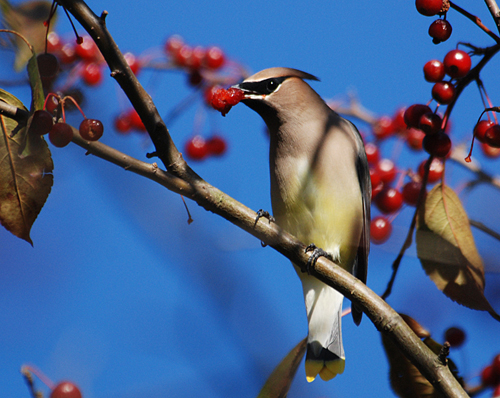Although we had a very average September (numerous days with southeast winds did not help), captures dramatically increased in October. A high diversity of warblers remained through early October, and they were replaced by exceptionally high numbers of Yellow-rumped Warblers. We also were fortunate to capture some rather unusual species.

One of 3 Pine Warblers banded on a single day in early October. We only capture about one of these a year, making 3 in a day quite a surprise.

One of the 28 Black-throated Blue Warblers banded in October. This adult female was the last of the season and was captured on October 22. BTBWs can double brood and, as a result, are known to be late migrating warblers.

This adult male Chestnut-sided Warbler was migrating through unusually late when it was captured and banded on October 26.

A more typical capture in mid October - An Orange-crowned Warbler.

We had a near record year for Yellow-rumped Warblers as 959 of them were banded. All but 9 were banded in October as they moved through in very high numbers during a period of a couple weeks. This individuals was identified as a hatching year bird with an unusual amount of juvenile feathers in the greater coverts (outer 5). Since Setophaga (previously Dendroica) warblers often replace some greater coverts during the pre-alternate molt, this bird may have 3 generations of feathers within the greater coverts during next spring/summer.

It is well known that Yellow-rumped Warblers often consume poison ivy berries during fall migration, and the abundance of these berries at Powdermill is one reason we were able to band so many YRWAs this fall. Pictured is a bird preparing to forage on poison ivy berries.

This Carolina Chickadee banded in October was a first of the year capture. Notice the very gray colored greater coverts. Small wing and tail measurements confirmed this to be a Carolina rather than the more common Black-capped Chickadee.

An open wing photo of the same Carolina Chickadee.

One of 2 Wilson's Snipes captured this fall.

An open wing photo of the snipe. The molt limits among the wing coverts identified this as a hatching-year bird.

Probably the most unexpected bird captured this fall (but check the sparrow page) was the American Bittern. This was only the 5th Am. Bittern banded at Powdermill over 50 years!

Although the bittern growled nearly the entire time it was being processed, it was not too aggressive with its bill.

The bittern flying off after its release.

Another nice wading bird capture was this Green Heron.

A hatching-year Sharp-shinned Hawk was one of only three banded this fall.

Our only Eastern Screech Owl was banded in October.

We had good luck with Pileated Woodpeckers with 3 being banded this fall. Two of them were captured together in the same net!

Flocks of Cedar Waxwings were around the banding area for several weeks in late October as they took advantage of the abundant fruit resources.

Oooops, dropped the fruit!
These colorful images were taken by Fabian Meijer. He seems to have a knack for capturing great photos when only having a few spare minutes!

An Osprey flying over the ponds at the station.

A Ruffed Grouse strutting along the side of a local road.

A Ruby-crowned Kinglet on a sunny fall day.

A late migrating Ovenbird in the morning sun.

One of the 10 Saw-whet Owls banded at Powdermill this fall. We also captured 2 owls banded somewhere else and are waiting to hear where those birds came from.

A Pied-billed Grebe on Crisp Pond (largest pond in the banding area)

A Little Brown Bat found roosting on the exterior of the maintenance barn.

A view in front of the banding lab on a brisk fall evening.

The same view at dawn just before a strong storm system passed through.
Again, we thank Fabian Meijer for a number of great photos of birds in the hand and the bush.
